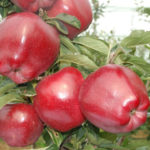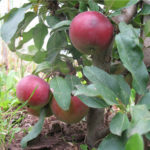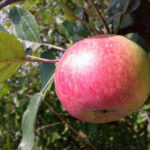Apple variety Uspenskoe
Despite the fact that the Uspenskoe variety has recently become available to a wide range of gardeners in central Russia, it already occupies leading positions in the ratings of the best apple varieties, gaining 9.7 points out of 10 possible. Our heroine was obtained at the All-Russian Scientific Research Institute of Genetics and Breeding of Fruit Plants. I.V. Michurin. The author of the novelty N.I. Savelyev managed to breed an apple tree with fruits of high consumer qualities by crossing Bessemyanka Michurinskaya with American Prima. By the way, our heroine got her beautiful appearance along the American line, as well as excellent resistance to scab. The variety was transferred for state trials in 1999, and was included in the State Register of Breeding Achievements of the Russian Federation in 2004. Zoned across the Central Black Earth District, which includes 6 regions: Kursk, Belgorod, Voronezh, Tambov, Lipetsk and Orel. The ruddy beauty fell in love with gardeners so much that they affectionately christened her Uspenochka.

Description
The tree does not have great vigor of growth, develops slowly and does not differ in particular harmony. An adult plant has a height of 2 - 3 meters, the crown diameter does not exceed two meters. The crown is moderately thickened and spreading, slightly drooping, due to which the already low trunk is visually shortened. The skeletal branches of Uspensky are covered with gray bark and are compactly located. The angle of their departure from the trunk is close to right. Such an arrangement of the main branches of the apple tree is considered almost ideal, since it provides the most durable connection of the wood, therefore, even at the time of loading with the crop, you can not be afraid of painful breaks. Annual shoots are upright, not too long, rounded in cross section, brown-brown bark, average pubescence. Lentils are small, light. The foliage of the crown is good. The leaves of the variety are opposite, large, green, elongated, the tip is helical twisted, the base is rounded-wedge-shaped, the edges are wide-wavy, with large-crenate serration. A large number of large wavy leaves creates the illusion of a shaggy crown. The surface of the leaf blade is smooth, shiny, the nerve is tender. The petiole is long, not thick, uncolored. The crop is formed mainly on simple ringlets, spears and fruit twigs. The flowers are of a delicate light pink shade, large, the position of the petals is loosely fitting, the shape is small-chalky.
Apple fruits attract with excellent external data. The apples are the same, aligned, of the correct round-oval shape, smooth. The skin is not thick, dense, dry to the touch, shiny. The main color of the fruits of the Uspensky is greenish-yellow, the integumentary color in the form of a blurred red blush covers most of the surface. On the lighted side, the blush is very bright. The funnel is of medium size, rusting is absent or only slightly manifested. Shallow saucer, medium width, closed cup. The sub-cup tube is short, connected to the heart. Seed chambers are semi-open, medium in size. Seeds are teardrop-shaped, dark brown, not very large. The peduncle is straight, short, strong, medium thick. The fruits of the variety are quite large. The mass of one apple is 180 - 200 grams. According to the State Register, the average fruit weight of this apple tree was 160 grams.
The pulp is white, without colored veins, tender, juicy. It is fine-grained in consistency, has a pleasant, but mild aroma. The taste is good, sweet and sour. But the assessment of the tasters still ranges from 4.2 to 4.6 points. The pulp has a high content of vitamin C. The chemical composition of 100 grams of raw pulp: soluble solids 16.1%, sugars 11.5%, ascorbic acid 26.4 mg, P-active compounds 396 mg.
Characteristics
- Uspenskoe belongs to the autumn varieties. Fruits ripen in September;
- early maturity is average. The seedling most often enters the fruiting season 5 years after planting.With rare exceptions, an apple tree can bring a harvest in 4 years;
- the crop shows regular fruiting;
- according to the State Register, the average yield for the years of variety testing from 1998 to 2003 was 199 c / ha, which is 20 c / ha higher than the control variety. VNIISPK also notes the high yield of our heroine, according to their data, it is 200 - 250 c / ha. Other Internet sources note that 35 - 40 kg of fruit can be harvested from one tree;
- a large harvest must be removed in time, since when overripe apples are prone to shedding;
- the culture is highly adaptive, resistant to abiotic stresses (factors of inanimate nature), the author of the variety notes a high level of resistance in terms of winter hardiness components (at the level of Antonovka and Brown striped). The apple tree is able to withstand -30 ° C at the beginning of winter and -40 ° C in the middle without obvious damage. After the thaw + 3 ° С, it withstood sharp drops in temperature to -25 ° С. According to S.T. Esichev, after the winter of 2009 - 2010, the total degree of freezing of plants in the young garden (laying in 2005 - 2007) ranged from 1 to 1.5 points, in the old garden - up to 0.5 points. According to VNIISPK, after artificial freezing to -40 ° C in the middle of wintering, the bark and cambium did not freeze, the degree of kidney damage did not exceed 0.5 points, xylem - 0.7 points;
- immunity is good. Uspenskoe is valued for its monogenic resistance to scab controlled by the Vf gene, which is especially important for central Russia, where in recent decades this disease has greatly harmed apple orchards;
- the crop tolerates transportation well. True, it does not differ in keeping quality, it can be stored for only 2 - 3 months, after which the pulp of the fruit becomes friable and tasteless;
- the way of use is universal. First of all, the fruits of this apple tree are good in their natural form, as they have a good taste and are rich in vitamin C. They are also used to make jam, juice, compote, baby food, and apple chips.
Pollinators
There is no information about the self-fertility of the variety in the State Register and on the VNIISPK website. Various Internet sources provide conflicting information on this matter. But in any case, in many gardens there are summer and autumn apple varieties that will help Uspensky to form a better harvest.
Planting and leaving
You can plant an apple tree in spring and autumn, the main thing is to have time to keep within the prescribed time frame. The variety is unpretentious, but still differs in some nuances that relate to the rules of planting and leaving. The place should be taken away from the sun, the groundwater level should not come closer than 1.5 - 2 meters to the surface. Loams with neutral acidity are suitable from soils, although with a properly prepared planting pit, the plant can also be planted in clay soil. Watering is carried out as needed, you need to ensure that the soil is in a moderately moist state. Nitrogen fertilizers applied in spring will promote good shoot growth. At the end of summer, only phosphorus-potassium fertilizers should be applied. In the spring, an older tree is thinned out, thereby freeing the crown from excessive thickening, which in turn has a beneficial effect on the health of the plant and the formation of large fruits.
Uspenskoe is a worthy variety for the Central Black Earth Region of Russia. The crop is very fruitful, does not suffer from the frequency of fruiting. Apples have high commercial qualities and good taste, and are also rich in vitamin C. The monogenic resistance of the apple tree to scab and excellent winter hardiness are of great importance. And the tree itself, despite the drooping shape of the crown, looks very beautiful during the flowering and fruiting period. Of course, he also has disadvantages. The fruits are stored for a short period, so if the harvest is good, then part of it can be successfully processed.But before that, you need to have time to collect the fruits in time, otherwise part of the crop may crumble.








